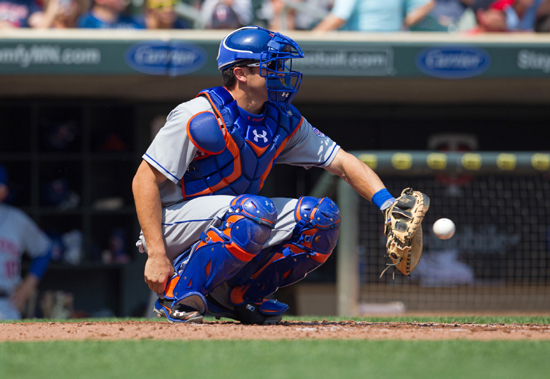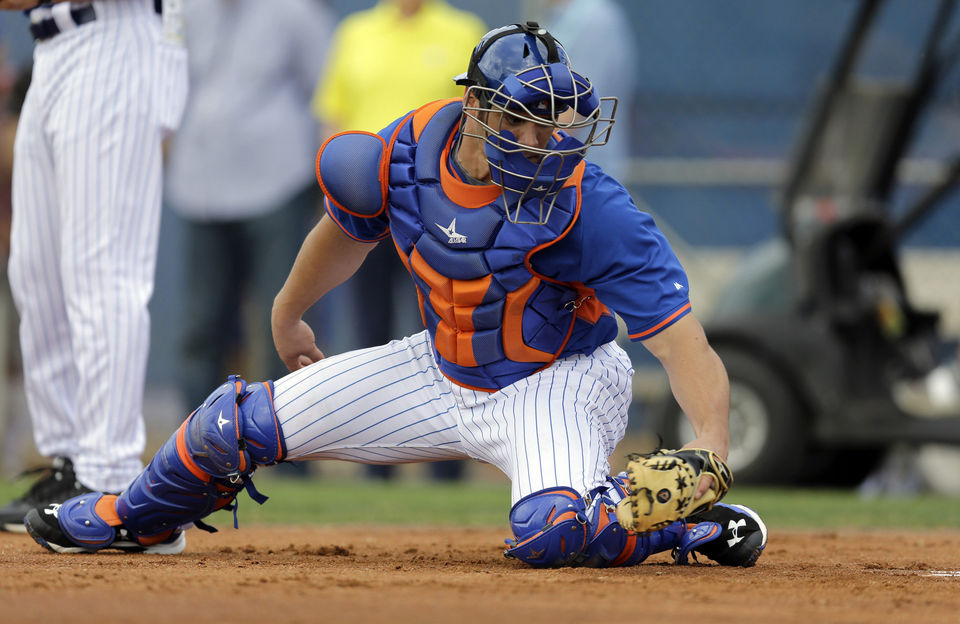Last week, we began our season previews for this year’s Mets squad as they gear up for Opening Day a week from now. So far, we’ve covered the starting rotation and the bullpen. This week, we’ll cover the catching position, the infield, the outfield, and the bench. Enjoy!
Travis d’Arnaud
 2014 was a tale of two seasons for the young Travis d’Arnaud. The first, which lasted from Opening Day until June 6, when d’Arnaud was sent down to Triple-A, had some Mets fans ready to give up on the top prospect. However, about two and a half seemingly magical weeks in the minor leagues turned d’Arnaud’s season around completely.
2014 was a tale of two seasons for the young Travis d’Arnaud. The first, which lasted from Opening Day until June 6, when d’Arnaud was sent down to Triple-A, had some Mets fans ready to give up on the top prospect. However, about two and a half seemingly magical weeks in the minor leagues turned d’Arnaud’s season around completely.
Through June 6, d’Arnaud hit .180/.271/.273 with just three home runs in 145 plate appearances. After two weeks in Las Vegas, in which he hit six home runs in 15 games, d’Arnaud returned to the Mets, and it got nothing but better for the young catcher. After returning, he hit .272/.319/.486 with ten home runs in 276 plate appearances. If he had put up those numbers all season, his OPS (.805) would have been sixth among catchers with 300 or more plate appearances. These 69 games were what scouts dreamed about d’Arnaud doing for years.
In Las Vegas, d’Arnaud and hitting coach George Greer moved his back foot closer to the plate with the hopes of it helping him hit the outside pitch. Looking at his zone profiles, courtesy of Brooks Baseball, the difference was clear.
Before Demotion to Las Vegas
After Return to Mets

As you can see, d’Arnaud’s ability to hit the outside pitch before the work in Triple-A was basically nonexistent. After returning, he became a far more balanced hitter. If he can keep this issue at bay, he has a chance to have an outstanding season offensively. He has proven that he can be among the best hitting catchers in baseball, he just has to sustain it.
Defensively, d’Arnaud was a mixed bag. He was a great pitch framer, but occasionally had some trouble blocking pitches behind the plate. He finished the year with a -15 Defensive Runs Saved and an RPP (Catcher blocked pitches in runs above average) of -3.1. If d’Arnaud can continue to hit like he did from mid-June on, however, it really doesn’t matter how bad his defense it.
As for projecting this season, Steamer and ZiPS both project d’Arnaud to have a good season, although I think even those projections are a little conservative. I can definitely see d’Arnaud repeat his .800+ OPS over a full season, and thrust himself into the category of elite catcher.
Anthony Recker
 It seemed for a moment like Johnny Monell could actually make a run at the job of backup catcher, as he has had an incredible spring training so far. However, the job will most likely go to the more known quantity, 31 year-old Anthony Recker.
It seemed for a moment like Johnny Monell could actually make a run at the job of backup catcher, as he has had an incredible spring training so far. However, the job will most likely go to the more known quantity, 31 year-old Anthony Recker.
Recker had a down season last year after a 2013 campaign that had Mets fans optimistic about his future. In 2013, he posted a wRC+ of 95, not terrible for a backup catcher. However, Recker struggled significantly more last season, seeing his wRC+ drop 15 points to 75.
Recker provides some power off the bench, but at times has provided only that. His line last year was carried by his seven home runs. Otherwise, he didn’t do much over his 189 trips to the plate. He’s no Ramon Castro.
On defense, Recker threw out a well above average 37 percent of runner trying to steal while on the other hand, according to Baseball Prospectus, he was terrible at framing pitches, something d’Arnaud is notorious for.
Steamer and ZiPS both have Recker around .207/.270/.360, which amounts to around an 80 wRC+, not quite what you are looking for in a backup catcher. He will have to do better than that to keep his job.
Make sure to follow me on Twitter @connor_obrien97. And make sure to check back later this week for more previews of the 2015 Mets season.

















